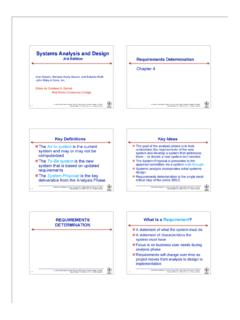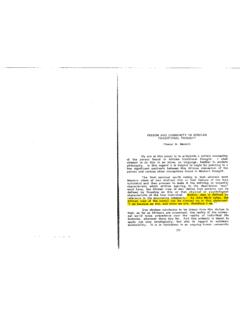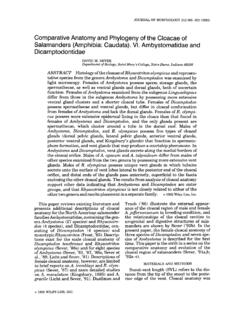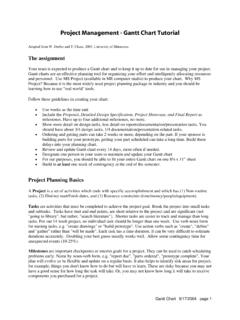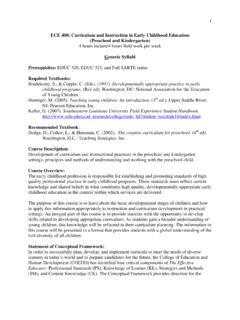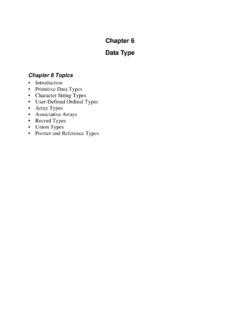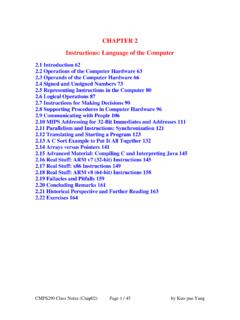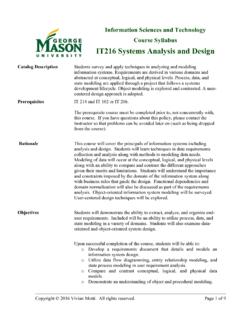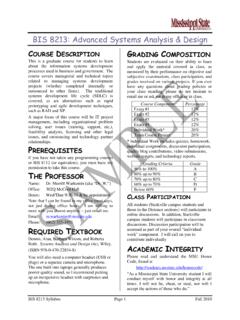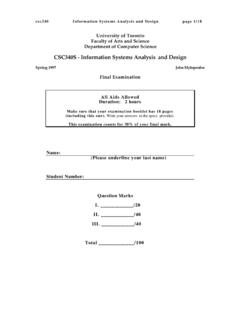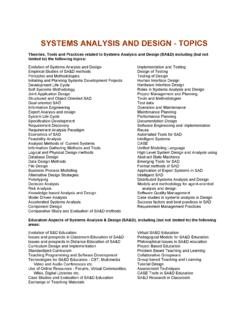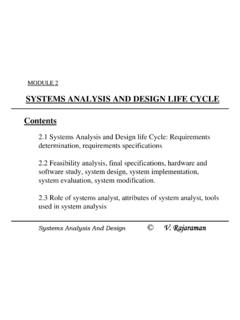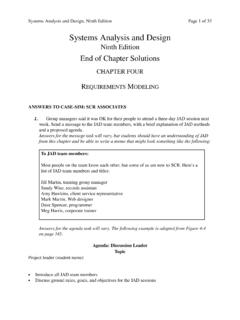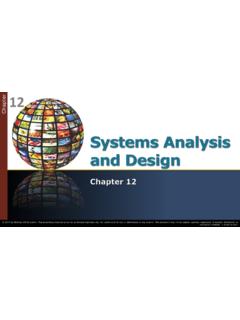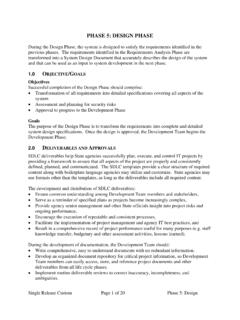Transcription of Systems Analysis and Design Third Edition Planning
1 Pow erPoint Presentation for Dennis, Wixom & Roth Systems Analysis and Design , 3rd EditionCopyright 2006 John Wiley & Sons, Inc. All rights - 1 Systems Analysis and DesignSystems Analysis and DesignThird EditionThird EditionAlan Dennis, Barbara Haley Wixom, and Roberta RothJohn Wiley & Sons, by Candace S. Garrod Red Rocks Community CollegePow erPoint Presentation for Dennis, Wixom & Roth Systems Analysis and Design , 3rd EditionCopyright 2006 John Wiley & Sons, Inc. All rights - 2 PlanningPlanningChapter 1 Pow erPoint Presentation for Dennis, Wixom & Roth Systems Analysis and Design , 3rd EditionCopyright 2006 John Wiley & Sons, Inc. All rights - 3 The Systems Development Life Cycle(SDLC)Pow erPoint Presentation for Dennis, Wixom, & Roth Systems Analysis and Design , 3rd EditionCopyright 2006 John Wiley & Sons, Inc. All rights - 4 The SDLC is composed of fourfundamental phases:PlanningAnalysisDesignImplementat ionPow erPoint Presentation for Dennis, Wixom, & Roth Systems Analysis and Design , 3rd EditionCopyright 2006 John Wiley & Sons, Inc.
2 All rights - 5 Each of the phases include a set ofsteps, which rely on techniques thatproduce specific document files thatprovide understanding about erPoint Presentation for Dennis, Wixom, & Roth Systems Analysis and Design , 3rd EditionCopyright 2006 John Wiley & Sons, Inc. All rights - 6To Understand the SDLC:Each phase consists of steps that leadto specific deliverablesThe system evolves through gradualrefinementPow erPoint Presentation for Dennis, Wixom, & Roth Systems Analysis and Design , 3rd EditionCopyright 2006 John Wiley & Sons, Inc. All rights - 7 Phase I: PlanningPow erPoint Presentation for Dennis, Wixom, & Roth Systems Analysis and Design , 3rd EditionCopyright 2006 John Wiley & Sons, Inc. All rights - 8 This phase is the fundamental processof understanding why an informationsystem should be Planning phase will also determinehow the project team will go aboutbuilding the information Planning phase is composed of twoplanning erPoint Presentation for Dennis, Wixom, & Roth Systems Analysis and Design , 3rd EditionCopyright 2006 John Wiley & Sons, Inc.
3 All rights - 9 Two Planning StepsPow erPoint Presentation for Dennis, Wixom, & Roth Systems Analysis and Design , 3rd EditionCopyright 2006 John Wiley & Sons, Inc. All rights - 10 During project initiation, the system sbusiness value to the organization isidentified (How will it lower costs or increaserevenues?) During project management, the projectmanager creates a work plan, staffs theproject, and puts techniques in place to helpthe project team control and direct the projectthrough the entire erPoint Presentation for Dennis, Wixom, & Roth Systems Analysis and Design , 3rd EditionCopyright 2006 John Wiley & Sons, Inc. All rights - 11 Phase II: AnalysisPow erPoint Presentation for Dennis, Wixom, & Roth Systems Analysis and Design , 3rd EditionCopyright 2006 John Wiley & Sons, Inc. All rights - 12 The Analysis phase answers the questions ofwho will use the system , what the system willdo, and where and when it will be this phase the project teaminvestigates any current system (s), identifiesimprovement opportunities, and develops aconcept for the new phase has three Analysis erPoint Presentation for Dennis, Wixom, & Roth Systems Analysis and Design , 3rd EditionCopyright 2006 John Wiley & Sons, Inc.
4 All rights - 13 Three Analysis Steps Analysis strategy: This is developed toguide the projects team s efforts. Thisincludes an Analysis of the current system . Requirements gathering: The Analysis ofthis information leads to the development ofa concept for a new system . This concept isused to build a set of Analysis models. system proposal: The proposal ispresented to the project sponsor and otherkey individuals who decide whether theproject should continue to move erPoint Presentation for Dennis, Wixom, & Roth Systems Analysis and Design , 3rd EditionCopyright 2006 John Wiley & Sons, Inc. All rights - 14 The system proposal is the initial deliverablethat describes what business requirements thenew system should deliverable from this phase is both ananalysis and a high-level initial Design for thenew erPoint Presentation for Dennis, Wixom, & Roth Systems Analysis and Design , 3rd EditionCopyright 2006 John Wiley & Sons, Inc.
5 All rights - 15 Phase III: DesignPow erPoint Presentation for Dennis, Wixom, & Roth Systems Analysis and Design , 3rd EditionCopyright 2006 John Wiley & Sons, Inc. All rights - 16In this phases it is decided how thesystem will operate, in terms of thehardware, software, and networkinfrastructure; the user interface, forms,and reports that will be used; and thespecific programs, databases, and filesthat will be erPoint Presentation for Dennis, Wixom, & Roth Systems Analysis and Design , 3rd EditionCopyright 2006 John Wiley & Sons, Inc. All rights - 17 Five Design Steps Design Strategy: This clarifies whether thesystem will be developed by the company oroutside the company. Architecture Design : This describes thehardware, software, and networkinfrastructure that will be used. Database and File Specifications: Thesedocuments define what and where the datawill be stored.
6 Program Design : Defines what programsneed to be written and what they will erPoint Presentation for Dennis, Wixom, & Roth Systems Analysis and Design , 3rd EditionCopyright 2006 John Wiley & Sons, Inc. All rights - 18 Phase IV: ImplementationPow erPoint Presentation for Dennis, Wixom, & Roth Systems Analysis and Design , 3rd EditionCopyright 2006 John Wiley & Sons, Inc. All rights - 19 During this phase, the system is eitherdeveloped or purchased (in the case ofpackaged software).This phase is usually the longest andmost expensive part of the phase has three erPoint Presentation for Dennis, Wixom, & Roth Systems Analysis and Design , 3rd EditionCopyright 2006 John Wiley & Sons, Inc. All rights - 20 Three Implementation StepsPow erPoint Presentation for Dennis, Wixom, & Roth Systems Analysis and Design , 3rd EditionCopyright 2006 John Wiley & Sons, Inc.
7 All rights - 21 system Construction: The system isbuilt and tested to make sure it performsas : Prepare to support theinstalled Plan: Includes a post-implementation erPoint Presentation for Dennis, Wixom, & Roth Systems Analysis and Design , 3rd EditionCopyright 2006 John Wiley & Sons, Inc. All rights - 22 Systems Development MethodologiesPow erPoint Presentation for Dennis, Wixom, & Roth Systems Analysis and Design , 3rd EditionCopyright 2006 John Wiley & Sons, Inc. All rights - 23A methodology is a formalized approachto implementing the methodology will vary depending onwhether the emphasis is on businessesprocesses or on the data that supportsthe erPoint Presentation for Dennis, Wixom, & Roth Systems Analysis and Design , 3rd EditionCopyright 2006 John Wiley & Sons, Inc. All rights - 24 Process-centered MethodologiesWith this methodology, the focus is on definingthe activities associated with the concentration is on representing thesystem concept as a set of processes withinformation flowing into and out of erPoint Presentation for Dennis, Wixom, & Roth Systems Analysis and Design , 3rd EditionCopyright 2006 John Wiley & Sons, Inc.
8 All rights - 25 Data-centered MethodologiesPow erPoint Presentation for Dennis, Wixom, & Roth Systems Analysis and Design , 3rd EditionCopyright 2006 John Wiley & Sons, Inc. All rights - 26 This methodology focuses on definingthe content of the data storagecontainers and how they are methodologies utilizedata models as the core of the erPoint Presentation for Dennis, Wixom, & Roth Systems Analysis and Design , 3rd EditionCopyright 2006 John Wiley & Sons, Inc. All rights - 27 Object-oriented MethodologiesPow erPoint Presentation for Dennis, Wixom, & Roth Systems Analysis and Design , 3rd EditionCopyright 2006 John Wiley & Sons, Inc. All rights - 28 This methodology attempts to balancethe focus between processes and Unified Modeling Language (UML)is used to describe the system conceptas a collection of objects incorporatingboth data and erPoint Presentation for Dennis, Wixom, & Roth Systems Analysis and Design , 3rd EditionCopyright 2006 John Wiley & Sons, Inc.
9 All rights - 29 Category I of the SystemDevelopment Methodology: Structured DesignPow erPoint Presentation for Dennis, Wixom, & Roth Systems Analysis and Design , 3rd EditionCopyright 2006 John Wiley & Sons, Inc. All rights - 30 Structured Design methodologies adopt aformal step-by-step approach to the SDLC thatmoves logically from one phase to the Design methodology introduces the use offormal modeling or diagramming techniques todescribe a system s basic business processesand follows a basic approach of two structureddesign erPoint Presentation for Dennis, Wixom, & Roth Systems Analysis and Design , 3rd EditionCopyright 2006 John Wiley & Sons, Inc. All rights - 31 Waterfall DevelopmentPow erPoint Presentation for Dennis, Wixom, & Roth Systems Analysis and Design , 3rd EditionCopyright 2006 John Wiley & Sons, Inc. All rights - 32 With waterfall development- basedmethodologies, the analysts and users proceedsequentially from one phase to the two key advantages of waterfalldevelopment-based methodologies are:- The system requirements are identified longbefore programming Changes to the requirements are minimized asthe project erPoint Presentation for Dennis, Wixom, & Roth Systems Analysis and Design , 3rd EditionCopyright 2006 John Wiley & Sons, Inc.
10 All rights - 33 The two key disadvantages of waterfalldevelopment-based methodologies are:- The Design must be completely specifiedbefore programming A long time elapses between thecompletion of the system proposal in theanalysis phase and the delivery of the erPoint Presentation for Dennis, Wixom, & Roth Systems Analysis and Design , 3rd EditionCopyright 2006 John Wiley & Sons, Inc. All rights - 34 Waterfall Development-based MethodologyPow erPoint Presentation for Dennis, Wixom, & Roth Systems Analysis and Design , 3rd EditionCopyright 2006 John Wiley & Sons, Inc. All rights - 35 Parallel DevelopmentPow erPoint Presentation for Dennis, Wixom, & Roth Systems Analysis and Design , 3rd EditionCopyright 2006 John Wiley & Sons, Inc. All rights - 36 This methodology attempts to addressthe long time interval between theanalysis phase and the delivery of erPoint Presentation for Dennis, Wixom, & Roth Systems Analysis and Design , 3rd EditionCopyright 2006 John Wiley & Sons, Inc.
